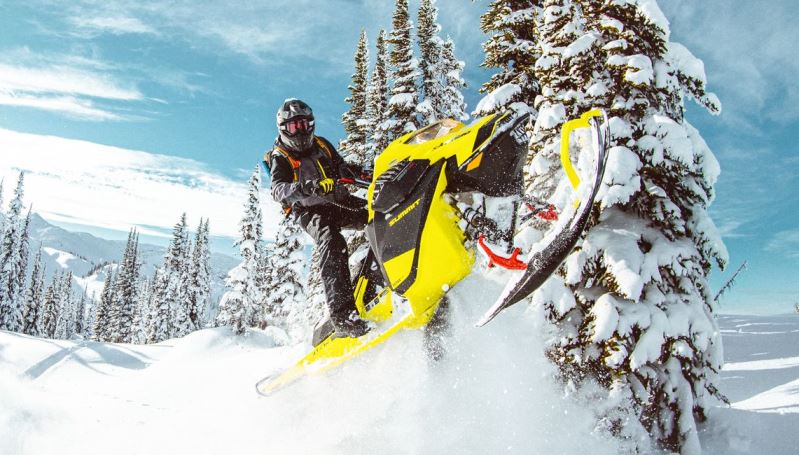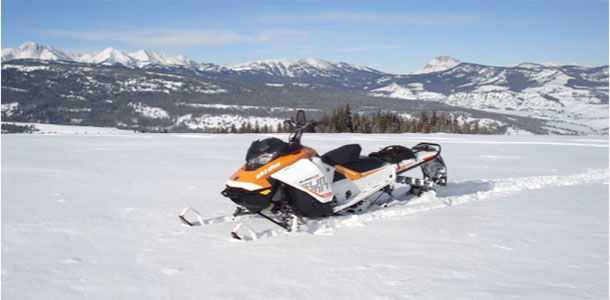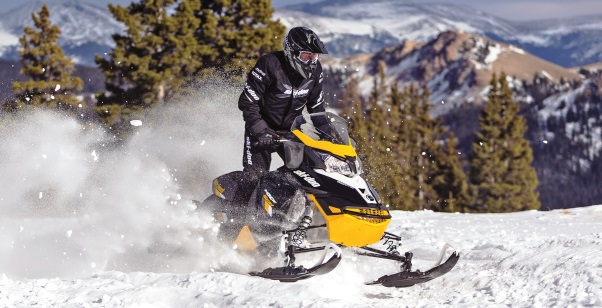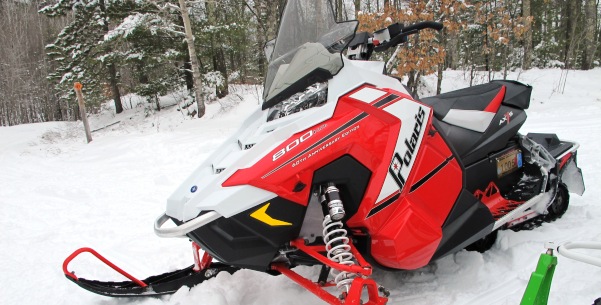Ski-Doo has extended mountain snowmobile riders’ expectations with the longest track ever in a stock snowmobile — 174 inches.
Armed with more track and blessed with new front and rear geometry, plus targeted weight savings, Ski-Doo’s T3-equipped Summit X promises better balance and up to 174 inches of whirring rubber to throw 3-inch paddles at the surface below.
Snow Goer had the opportunity to test drive the new T3 package in Colorado in January: What follows are some initial impressions. For the full first-ride review and technical details, pick up the April 2014 issue of Snow Goer magazine.

2015 Ski-Doo Summit 174 Test Ride: The Skinny
The most attention-grabbing feature of the new T3 package Ski-Doo Summit X models, available only as spring order models, is the massive track – 16-inches wide by either 174 or 163 inches long, with monster 3-inch lugs set at a 3-inch pitch. In addition to the traction improvement, though, Ski-Doo designers targeted weight reduction and overall machine balance.
Weight-shaving subtleties exist from the tips of the new Pilot DS3 skis to the rear idler wheels in the revised tMotion skidframe. The new ski has a deeper keel to match the added traction in back, while also featuring a new ribbed top section to hold less snow and keep the same supportive properties while decreasing the material weight.
That ski mates up to the new RAS2 front suspension. This setup revamps the geometry of the upper A-arms to improve rough bump absorption. The old front end would travel up and toe inward when encountering bumps, leading to the twitchy, jack-knifing behavior when entering a rough corner on full compression. The new geometry pairs optimized A-arm angles together to move the instant center of the front suspension and riase the sled’s roll center closer to the machine’s center of gravity. This new geometry eliminates the toe-in and controls the footprint of the ski, keeping more of the sole in full contact with the snow, all while dropping 1.76 pounds of weight through use of lightweight components and shaving excess material where it wasn’t needed.
Inside the engine compartment, the silencer has been reshaped to a cylinder instead of multi-paneled suitcase, dropping 5 pounds. The chaincase also received the attention of Ski-Doo engineers. The case is 1.1 inches longer to accommodate the new 3-inch paddles, but weight was minimized by machining the cover thinner and removing some unused mounting tabs. Even the web section on the gears inside the chaincase has been decreased in width to slightly more than 3/32-inch, shedding rotating mass.
To provide as much room as possible for the 3-inch lugs, 7-tooth, 3-inch pitch drivers are pressed onto the driveshaft. On the roof of the tunnel, there’s a fresh look for the cooling system. The heat exchanger only covers the rear half of the tunnel; aluminum tubing is used to reach from the bulkhead back to the start of the cooler, netting a claimed loss of 4 pounds in wet weight on the 174-inch model. Within the skidframe, all idler wheels have been removed except for two at the rear axle. The two rear wheels that spin around lighter machined axles even lost weight, as Ski-Doo removed the rubber band from the outside of the wheel, opting for solid circle of plastic. Two bi-directional ice scratchers mount to the front of the slide rails and can be stowed up on a small plastic hook for off trail riding. These changes strip away 2.56 pounds.
The suspension mounting locations in the tunnel have been moved downward 1 inch on both T3 units, and the rear mount of the 174 has moved 5 inches rearward.
Wrapping around the skidframe is the focal point of the new Summit T3 package – the PowderMax 3 track. Still incorporating the FlexEdge technology, Ski-Doo aptly noticed that the thick support bars (which housed the fiberglass rods) can be eliminated in the flexing zone, and four narrow slots have been cut on each row across the track. Couple these subtle changes with tighter tolerances to a pure 16-inch dimension, the 174-inch track lost 2.39 pounds compared to a same-length aftermarket track.
Total it up, and a T3-equipped 174 Summit X weighs the same (464 pounds) as a base 163 Summit X, and the new T3-equipped 163 weighs in similar (459 pounds) to a 153 X. Riders get the benefit of the extra traction and length, with no weight penalty.

2015 Ski-Doo Summit 174 Test Ride: “Poor Man’s Turbo”
The new Summit X T3 174 is a force to be reckoned with. Colloquially known as the “Poor Man’s Turbo,” a 3-inch track shines brightly when the snow gets deep. In the sugarized, lack-of-a-base riding conditions at the sneak peek ride in January, the 3-inch track proved itself time and time again on the steep, tree-lined slopes. It was possible to lose nearly all uphill momentum, return to the throttle and progress upward on the hill where other tracks would end up stuck.
Getting out of trenches hasn’t been a strong suit of the XMs as they often continue to trench without planing out (though it does look cool in the movies!), the added length and lug height of the 174 T3 allows the sled to behave in this manner with less severe consequences. Initiating a sidehill on the tMotion-equipped T3 sleds remained as easy as on the 2014 models requiring little rider effort. This makes the XM a treat to ride in fluffy snow conditions through tight trees, wide-open hillsides or along steep crevasses. Minimal hardpack backcountry area was ridden during our one-day ride, but the traits of the easy-to-roll sled we’re accustomed to were noticeable even in the parking lot.
Trail handling between the 163- and 174-inch T3 units showed no difference stemming from the added length. Ice scratchers were a definite necessity on the frozen morning trails to keep engine temps from spiking – sitting 3 inches off the snow surface will legitimately require the cooling spray offered by the Ski-Doo scratchers. The new front end was noticeable on a few portions of rough bumpy trail that we rode at the end of the day as we returned to the trailers. The sled’s direction of travel maintained more consistency with less twitch in the handlebars upon bump impacts. The inside ski lifted around most turns, but once the tMotion reaches its locking point, the roll stabilized slightly, allowing for a controlled turn.






